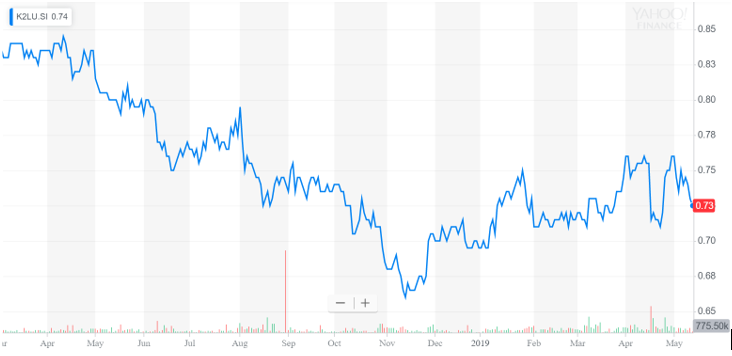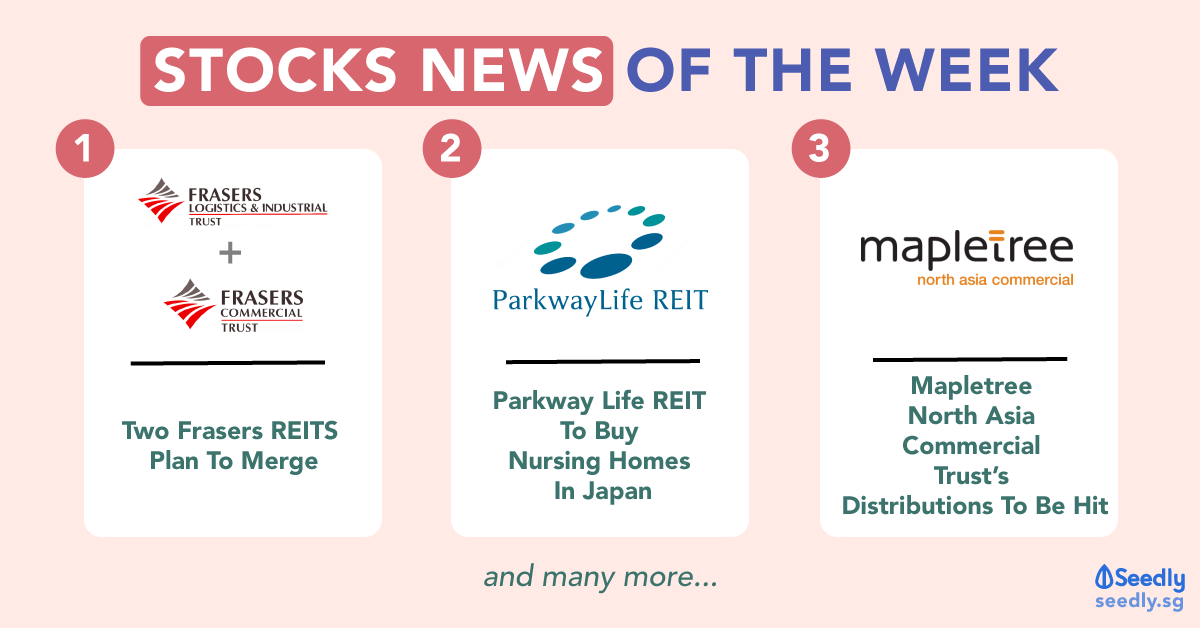
TL;DR: Cache’s Portfolio comprises 26 Logistics and Warehousing properties located in established logistics clusters in Singapore and Australia. Overall, they are facing some decline with a decrease in distribution over the years, but their yield, sitting at 8.50% is one of the highest for REITs in Singapore.
Share price movement

Credits: Yahoo Finance
The share price has seen fluctuations, and overall a decrease from the previous year. It is currently trading at $0.73 as at the time of writing (14 May 2019).
Financials

The increase in revenue came mainly from the acquisition of 9 properties in Australia. Net Property Income (NPI) from Australia rose by 60.9%, whereas NPI from Singapore dropped by 7.7%. Cache sold its Hi-Speed Logistics Centre located within Airport Logistics Park of Singapore at a consideration of $73.8m. Selling the property was part of rebalancing their portfolio for reinvestments into higher performing assets. The increase in property expenses corresponded to the increase in the number of Australian properties mainly.

Portfolio
Cache currently has 26 properties, comprising 10 in Singapore and 16 in Australia, marking FY2018 as the first year of having more properties in Australia than Singapore.

Revenue from China came before the divestment of the Jinshan Chemical warehouse early in 2018. Singapore still accounts for the bulk of the gross revenue of its portfolio, almost three times as much as Australia. Australia has a higher portfolio occupancy than Singapore, giving a total of 95% occupancy of its portfolio.

Lease expiry profile

The leases due over the next two years in FY2019 and FY2020 account for approximately 23.6% and 18.5% of Cache’s Gross Rental Income respectively. 61.5% of their leases are short term ie. up to three years. The stability of cash flows will depend on the quality of tenants and ability to secure new/renew current leases.
Tenant Diversification
The quality and diversification of tenants will mitigate concentration risk and determine the stability of cash flows of Cache. Cache’s tenants/end-users comprise largely multinational third-party logistics service providers (“3PLs”) and companies from diverse business sectors ranging from industrial and consumer goods to food and cold storage, materials, engineering, construction, healthcare and e-commerce.
Singapore Industrial Property Market Review
- The Government is actively promoting and helping the logistics sector improve productivity and remain competitive through digitalisation and skills training programs. To accelerate digitalisation in the logistics sector, the Logistics Industrial Digital Plan (“IDP”) developed by the Infocomm Media Development Authority (“IMDA”) provides funding for purchases of advanced technology solutions and automation under the Productivity Solutions Grant (“PSG”) funding to ensure SMEs become more competitive globally. As the government seeks to improve productivity and promote digitisation, this would therefore mean a high demand for industrial and logistics properties.
Australia Industrial Property Market Review
- Looking at their Australian properties, we see that they are spread across a few key cities.
- Overall in Australia, there is positive economic growth over 27 consecutive years due to the strong population growth rate. Emerging online retail market increasing industrial tenant demand, particularly from retail and logistics and transport-related users.
- A weaker Australian dollar boosting net exports and a growing eCommerce are some of the drivers of demand, leading to a low supply and high demand for industrial and logistics properties in Australia.
Challenges ahead
The three key challenges include leasing risks, strategic risks and also financial risks.
- Leasing risk
Given that 23.6% (by income) of their leases will expire in FY2019, it is a significant risk for them to be able to renew leases or secure new tenants to maintain a healthy occupancy rate. A good mix of tenants will be needed to diversify concentration risks.
- Strategic risk
They rebalanced their portfolio by divesting some properties and attaining more 7 more properties in Australia, under “rigorous, disciplined and thorough evaluation”. Cache also adopts asset enhancement, development and/or redevelopment initiatives when necessary to ensure that their properties remain relevant and competitive.
- Financial risk
Such include the foreign exchange risks, especially as Cache has a large percentage of Australian properties. They have hedged a significant portion of their forex risks by swapping into fixed interest rates. In addition, they also face some credit risks in the event their tenants fail to pay on time, especially when they have new tenants. Cache tackles this by conducting rigorous reviews of their tenants through credit assessments and evaluation on an ongoing basis to lower credit risks.







TL;DR: Cache’s Portfolio comprises 26 Logistics and Warehousing properties located in established logistics clusters in Singapore and Australia. Overall, they are facing some decline with a decrease in distribution over the years, but their yield, sitting at 8.50% is one of the highest for REITs in Singapore.
Share price movement
Credits: Yahoo Finance
The share price has seen fluctuations, and overall a decrease from the previous year. It is currently trading at $0.73 as at the time of writing (14 May 2019).
Financials
The increase in revenue came mainly from the acquisition of 9 properties in Australia. Net Property Income (NPI) from Australia rose by 60.9%, whereas NPI from Singapore dropped by 7.7%. Cache sold its Hi-Speed Logistics Centre located within Airport Logistics Park of Singapore at a consideration of $73.8m. Selling the property was part of rebalancing their portfolio for reinvestments into higher performing assets. The increase in property expenses corresponded to the increase in the number of Australian properties mainly.
Portfolio
Cache currently has 26 properties, comprising 10 in Singapore and 16 in Australia, marking FY2018 as the first year of having more properties in Australia than Singapore.
Revenue from China came before the divestment of the Jinshan Chemical warehouse early in 2018. Singapore still accounts for the bulk of the gross revenue of its portfolio, almost three times as much as Australia. Australia has a higher portfolio occupancy than Singapore, giving a total of 95% occupancy of its portfolio.
Lease expiry profile
The leases due over the next two years in FY2019 and FY2020 account for approximately 23.6% and 18.5% of Cache’s Gross Rental Income respectively. 61.5% of their leases are short term ie. up to three years. The stability of cash flows will depend on the quality of tenants and ability to secure new/renew current leases.
Tenant Diversification
The quality and diversification of tenants will mitigate concentration risk and determine the stability of cash flows of Cache. Cache’s tenants/end-users comprise largely multinational third-party logistics service providers (“3PLs”) and companies from diverse business sectors ranging from industrial and consumer goods to food and cold storage, materials, engineering, construction, healthcare and e-commerce.
Singapore Industrial Property Market Review
Australia Industrial Property Market Review
Challenges ahead
The three key challenges include leasing risks, strategic risks and also financial risks.
Given that 23.6% (by income) of their leases will expire in FY2019, it is a significant risk for them to be able to renew leases or secure new tenants to maintain a healthy occupancy rate. A good mix of tenants will be needed to diversify concentration risks.
They rebalanced their portfolio by divesting some properties and attaining more 7 more properties in Australia, under “rigorous, disciplined and thorough evaluation”. Cache also adopts asset enhancement, development and/or redevelopment initiatives when necessary to ensure that their properties remain relevant and competitive.
Such include the foreign exchange risks, especially as Cache has a large percentage of Australian properties. They have hedged a significant portion of their forex risks by swapping into fixed interest rates. In addition, they also face some credit risks in the event their tenants fail to pay on time, especially when they have new tenants. Cache tackles this by conducting rigorous reviews of their tenants through credit assessments and evaluation on an ongoing basis to lower credit risks.